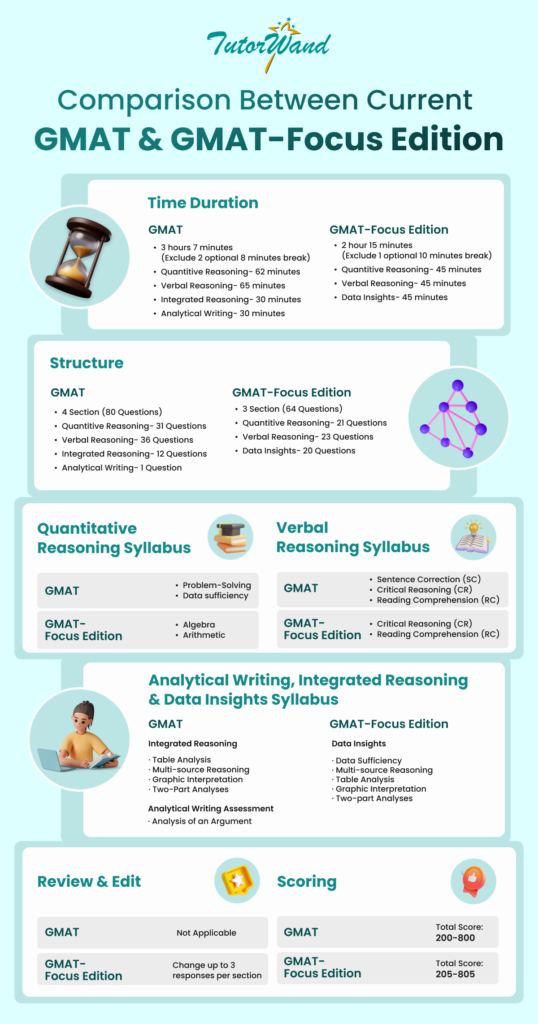In the world of standardized tests, few names command as much respect as that of the Graduate Management Admission Test, commonly referred to as the GMAT & now GMAT Focus Edition.
This examination has been a fundamental pillar in the MBA application process for countless years, opening doors to the world’s most prestigious business schools. But even the GMAT isn’t immune to change.
We’re now witnessing a significant transformation – the GMAT is donning a new avatar, the GMAT Focus Edition. Like a wine that improves with time, the test has been tweaked, polished, and refined over the years to stay relevant.
In this blog post, we’ll dive into the heart of these transformations and explore the aspects that have remarkably remained the same.
The Revised GMAT Format
GMAT announced some groundbreaking changes aimed at streamlining the test and enhancing the overall experience for students. The most notable alteration is the exam duration, reduced by almost an hour, now clocking in at 2 hours and 15 minutes.
This time reduction, achieved by eliminating the essay section, promises a less exhausting test-taking experience and focuses more on assessing the core skills necessary for business school.

Major Updates
The GMAT Focus Edition is more than just a time revision. It’s a thoughtful reshaping of the test that addresses long-standing critiques of the exam. The Analytical Writing Assessment section is no more, and a novel section, the GMAT Integrated Reasoning Challenge, takes the spotlight.
A significant emphasis on core business principles and skills has been added, making the test more relevant to the business world.
GMAT, Now More Flexible
GMAT test-takers now have the power to dictate the sequence of their exam. It’s a test-taker-friendly feature that allows students to start with any section and proceed in any order.
This flexibility empowers students to capitalize on their strengths and tailor their test-taking experience to their advantage.
What Remains The Same!
Despite the substantial changes, two sections stand firm – the Quantitative Reasoning and Verbal Reasoning sections. These two sections have remained consistent over the years, reflecting the enduring importance of these skills in the business world.
The Quant section continues to evaluate numerical acumen and analytical prowess, while the Verbal section assesses comprehension, critical reasoning, and command over the language.
What New?
In a world driven by data, it’s no surprise that the GMAT has incorporated a new Data Insights section.
This section is designed to evaluate candidates’ skills in data analysis, data interpretation, data visualization, and data-driven decision-making, replacing the Integrated Reasoning section of the previous format.
Syllabus
The updated GMAT syllabus can be summarized as follows:
Quantitative Reasoning
- Algebra
- Arithmetic
Verbal Reasoning
- Critical reasoning
- Reading comprehension
Data Insights
- Multi-source Reasoning = Examination or analyses of data from various sources (text, tables, graphics, or a combination of these) + recognition of discrepancy + inference + determination of the relevance of data
- Graphics Interpretation = Interpretation of information from graphics (scatter plot, x/y graph, bar chart, pie chart, or statistical curve distribution) + finding relationships + inference
- Two-part Analyses = Quant, Verbal, or a combination of both + evaluating trade-offs + solving simultaneous equations + finding relationships
- Data Sufficiency
- Table Analysis
Why Change Now?
One might wonder about the sudden change in the GMAT format. This major transformation stems from the rising competition from alternative tests like the GRE and the declining participation in GMAT test-taking over the years.
These challenges have spurred the GMAT to refurbish the test and realign it with the evolving needs of business schools and candidates.
What Does This Mean for You?
While these changes might feel overwhelming, remember that they are designed to make the GMAT more accessible and relevant.
So, whether you’re a first-time test-taker or re-attempting the exam, this is an opportunity to showcase your business aptitude and stand out in your MBA application.
Conclusion
Despite the surface-level changes, the essence of the GMAT remains the same – to assess a student’s readiness for the challenges of the business world.
The evolution of the GMAT signifies an adaptation to the changing times and the growing needs of business schools, while still adhering to the principles that have made it such an influential exam for all these years.



